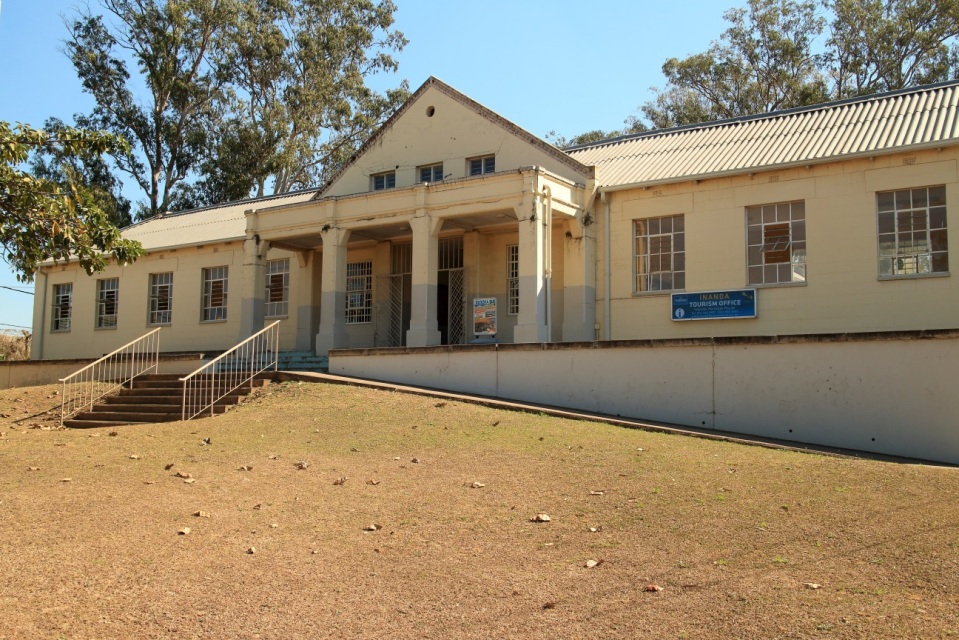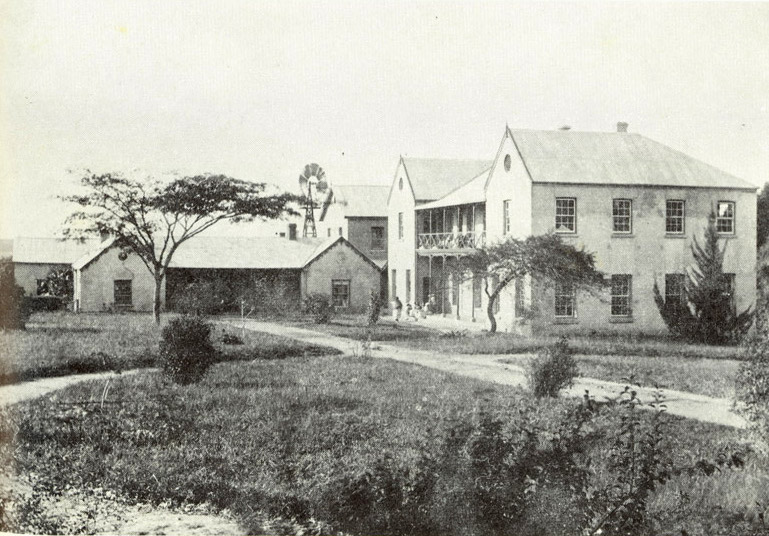The following text has been transcribed from a Durban City Guide, compiled for Durban Tourism by Sipho at the Khula-Use Group. The PDF corresponding to this text can be downloaded. I decided to put the text in a more searchable format because I could not find detailed information when planning my own trip to Inanda. I looked for, but did not find, a copyright notice on the document. The typing mistakes are my own. I have omitted the contact phone numbers for the individual sites, as I lack permission to make that information available via web. The hyperlinks were my additions, and I have added my own photographs for some sites or from Wikimedia / eNanda for others.
The Inanda Heritage Route allows a visit to some of Durban’s most important historical sites, places where South Africa’s future changed for the better because of the bravery of a few individuals. The Phoenix Settlement is where Mahatma Gandhi developed his philosophy of passive resistance, which has been lauded the world over, and his home has been turned into a monument dedicated to lasting peace and justice. At Inanda Township one can visit the Ohlange Institute, founded by the first president of the African National Congress, Rev. John Dube; this is also the site where Nelson Mandela cast his historical vote in South Africa’s first democratic elections in 1994. The Inanda Seminary is one of the oldest and most famous schools for girls in South Africa and has a legacy of producing some of the country’s finest black women leaders. Visits to these historic sites can be arranged through specialist tour operators.
Enquiries: Inanda Tourism +27(0)31 322 2856
INK is the acronym for Inanda, Ntuzuma & KwaMashu. These used to be stand-alone areas, but they were merged in 2001 to form one township. INK township is located about 25km north of Durban’s city centre. It is home to about 600 000 people – 18% of Durban’s population. It is a community with a large number of households that fall into the low-income bracket. Inanda is the oldest of the areas, established in the 1900s. KwaMashu was established between 1955 and 1966, and Ntuzuma was built in the 1970s. A catalyst of economic development in the area has been the establishment of shopping centres or malls in the area. KwaMashu Town Centre, Bridge City Mall & Dube Village Mall have brought some relief to the INK area. Government investment in INK’s electronic communication infrastructures has also helped a great deal in further developing the area. INK now has two community radio stations– Vibe FM & Inanda FM.
Phoenix Settlement
GPS: -29° 42′ 27.50″ +30° 58′ 34.95″ Google Maps

Phoenix Settlement was founded by Gandhi in 1904 after he visited the Trappist community at Marianhill and read John Ruskin’s “Unto This Last.” Phoenix represented a belief in the equality of all labour, the value of manual work and a simple communal lifestyle. The newspaper “Indian Opinion” was printed at Phoenix until its closure in 1961. Throughout its long history, Phoenix Settlement has always been at the forefront of struggle for justice, peace and equality. It was an important site of resistance during apartheid. Activists from all over the country came to Phoenix for political education and training programmes. During the “1985 Inanda Riots” much of the settlement was burnt to the ground, but after 1994 it was carefully reconstructed. Gandhi’s house Sarvodaya, the printing press building (today a community clinic), and the Phoenix Interpretation Centre all form part of the Phoenix Settlement.
Facilities: Toilets, Wheelchair friendly, Shopping
Shembe Settlement of Ekuphakameni
GPS: -29° 42′ 32.03″ +30° 57′ 46.36″ Google Maps

Isaiah Shembe, from Dictionary of African Christian Biography (via Wikimedia Commons)
Ekuphakameni, meaning “elevated place,” is the original settlement of Isaiah Shembe‘s religious community, Ibandla LamaNazaretha. The site was bought in 1914 after Shembe received instructions from God on the mountain of Nhlangakazi between 1910 and 1913. The community sees themselves as a nation chosen by God, not unlike the nation of Israel. The site houses the original Shembe temple, built in 1918 by Shembe volunteers, and the mausoleum of Isaiah Shembe. White stones are used to mark sacred spaces. Every year, in January, thousands of believers gather at Ekuphakameni for the annual pilgrimage to the holy mountain of Nhlangakazi and again in July for a festival of dance and praise. In 1976 a succession conflict resulted in a split. Bishop Landankosi Insikayakho (Landa) Shembe and his followers remain at Ekuphakameni while Bishop Amos Khula Shembe and his followers settled at Ebuhleni.
Facilities: Toilets, Wheelchair friendly
Ohlange Institute
GPS: -29° 41′ 57.32″ +30° 57′ 26.76″ Google Maps
 The Zulu Christian Industrial School, or Ohlange Institute, was founded by John Dube in 1900. John Dube fundraised in the United States for the school he intended to start in Natal. The hill on which the school was built was known as Ohlange, from uhlanga, meaning the origin of new growth. Building started in 1900 and the Zulu Christian Industrial School, later known as Ohlange Institute, opened on 26 July, 1901, the first black controlled institution of its kind in South Africa. John Dube’s first house is on the Ohlange site, as is the JL Dube Hall, where Nelson Mandela voted in the first democratic election in 1994. John Dube and his second wife, Angelina, are buried at Ohlange. He was the first president of the ANC (African National Congress).
The Zulu Christian Industrial School, or Ohlange Institute, was founded by John Dube in 1900. John Dube fundraised in the United States for the school he intended to start in Natal. The hill on which the school was built was known as Ohlange, from uhlanga, meaning the origin of new growth. Building started in 1900 and the Zulu Christian Industrial School, later known as Ohlange Institute, opened on 26 July, 1901, the first black controlled institution of its kind in South Africa. John Dube’s first house is on the Ohlange site, as is the JL Dube Hall, where Nelson Mandela voted in the first democratic election in 1994. John Dube and his second wife, Angelina, are buried at Ohlange. He was the first president of the ANC (African National Congress).
Facilities: Toilets, Wheelchair friendly
Inanda Seminary
GPS: -29° 42′ 27.91″ +30° 55′ 26.10″ Google Maps

Edwards Hall and Lucy Lindley Hall, from WikiMedia Commons
Inanda Seminary for Girls was the first school of its kind for black girls in southern Africa. Daniel and Lucy Lindley, American Board missionaries based at eNanda, felt that there was a need for a school for black girls that would teach them the Christian faith and prepare them for their roles as wives and mothers. The American Board Mission gave £50 to the project, and Inanda Seminary opened on 1 March, 1869. There were 19 students, all of them boarders. Mary Kelly Edwards, a 40-year-old widow from Ohio, was appointed the first principal. Inanda Seminary was one of few mission schools in South Africa that managed to remain independent throughout the apartheid years. Today it remains the oldest boarding school for girls in Southern Africa and continues to produce fine young women in all spheres of life. It has a very interesting and well-maintained museum and an archive on site.
Facilities: Toilets, Wheelchair friendly
Shembe Settlement of Ebuhleni
GPS: -29° 42′ 09.8″ +30° 53′ 21.0″ Google Maps

Image from eNanda
Ebuhleni is the home to Ebuhleni Shembe International Church. In 1976 after a succession dispute, this religious community broke away from the original Shembe community, Ibandla LamaNazaretha. In 1980, Bishop Amos Khula Shembe established Ebuhleni, meaning “place of beauty” on the plateau of Mtabutule. The site is situated in scannah grasslands and surrounded by cliffs, protruding out next to the wall of the Inanda dam. The settlement of Ebuhleni is nearly a kilometre in diameter, with men and women separated on either side of the entrance road. Every year in January, Ebuhleni attracts thousands of believers for the annual pilgrimage (two weeks after Ibandla LamaNazaretha have made a similar pilgrimage) to the holy mountain of Nhlanakazi and again in July for a festival of dance and praise.
Facilities: Toilets, Wheelchair friendly
Mzinyathi Falls
GPS: -29° 41′ 51.55″ +30° 54′ 19.21″ Google Maps

The Mzinyathi Falls is a sacred waterfall used for religious rituals such as the baptism of Ibandla LamaNazaretha. The falls and the surrounding area are also used by a Rastafarian community who live in a cliffside cave below the view site.
Facilities: Toilets, Wheelchair friendly [I dispute both claims.]
Inanda Dam
GPS: -29° 41′ 30.04″ +30° 53′ 21.43″ Google Maps

Photograph by LandyZA (via WikiMedia Commons)
The Inanda Dam is an important water reservoir in the eThekwini area, with its surface area covering 1463 hectares. Before the dam was constructed, 26 important archaeological sites were excavated, with artifacts dating back to the Stone Age. Also, early Stone Age sites in the excavated area indicated that Bantu people lived in this area as long as a thousand years ago. Today the dam is a popular water sports and recreation site and is known for its bass fishing.
Facilities: Toilets, Wheelchair friendly
